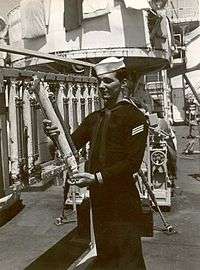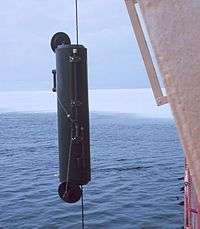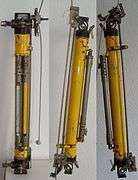Nansen bottle


A Nansen bottle is a device for obtaining samples of seawater at a specific depth. It was designed in 1894 by the early 19th to 20th-century explorer and oceanographer Fridtjof Nansen and further developed by Shale Niskin in 1910. (Niskin was born 1920!)
The bottle, more precisely a metal or plastic cylinder, is lowered on a cable into the ocean, and when it has reached the required depth, a brass weight called a "messenger" is dropped down the cable. When the weight reaches the bottle, the impact tips the bottle upside down and trips a spring-loaded valve at the end, trapping the water sample inside. The bottle and sample are then retrieved by hauling in the cable.
A second messenger can be arranged to be released by the inverting mechanism, and slide down the cable until it reaches another Nansen bottle. By fixing a sequence of bottles and messengers at intervals along the cable, a series of samples at increasing depth can be taken from a single action.
The sea temperature at the water sampling depth is recorded by means of a reversing thermometer fixed to the Nansen bottle. This is a mercury thermometer with a constriction in its capillary tube which, when the thermometer is inverted, causes the thread to break and trap the mercury, fixing the temperature reading. Since water pressure at depth will compress the thermometer walls and affect the indicated temperature, the thermometer is protected by a rigid enclosure. A non-protected thermometer is paired with the protected one, and comparison of the two temperature readings allows both temperature and pressure at the sampling point to be determined.
The Nansen bottle has a largely been superseded by the Niskin bottle and now is no longer under manufacture, though it still sees use.
Niskin bottle

The Niskin bottle is a development of the Nansen bottle patented by Shale Niskin in March 1966. Instead of a metal bottle sealed at one end, the 'bottle' is a tube, usually plastic to minimize contamination of the sample, and open to the water at both ends. Each end is equipped with a cap which is either spring-loaded or tensioned by an elastic rope. The action of the messenger weight is to trip both caps shut and seal the tube.
A reversing thermometer may also be carried on a frame fixed to the Niskin bottle. Since there is no rotation of the bottle to fix the temperature measurement, the thermometer has a separate spring-loaded rotating mechanism of its own tripped by the messenger weight.
A modern variation of the Niskin bottle uses actuated valves that may be either preset to trip at a specific depth detected by a pressure switch, or remotely controlled to do so via an electrical signal sent from the surface. This arrangement conveniently allows for a large number of Niskin bottles to be mounted together in a circular frame termed a rosette. As many as 36 bottles may be mounted on a single rosette.
Thermistor temperature sensors are more commonly employed on Niskin bottle rosettes due to their higher accuracy compared to mercury thermometers.
Image Gallery
References
- An Introduction to Physical Oceanography, M. Tomczak
- US Coast Guard International Ice Patrol, Oceanographic equipment
- Our Ocean Planet: Oceanography in the 21st Century, Robert Stewart
